

German M1918 helmet
This helmet is restaurated with a Swiss liner and is overpainted.
(When I bought this helmet many years ago, it was painted Silver and had no liner).
No inscriptions found. This was my first helmet ever, bought in 1993.


Swiss M1918-40 helmet
(Seems to have the old M1918 liner instead of the updated one).
No inscriptions stamped in the helmet.



German M1935 Feuerschutzpolizei helmet
I bought this one covered with black paint, no decals and no liner. Rivetted airvents.
I restored it with water transfer decals and a aluminum-type liner. Since there
is no layer of paint beneath the last one, I assume it is a postwar Feuerwehr helmet, but
made of a genuine WWII shell... inscriptions: ET62 at the inside (Eisenhütte Thale and shellsize) and production run 3607 at the back skirt of the shell.


German M1942 helmet
The last model of WWII (exept a testmodel from 44-45, but this was never issued).
This helmet has stamped out air vents instead of rivetted ones. The skirt is also flared out.
Comes with a repro liner with zinc band and repro chinstrap.
inscriptions: ET62 (Eisenhütte Thale) and productionrun 2137
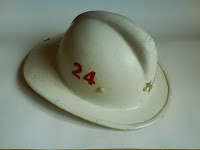

Belgian fireman Levior helmet
Last model of a series what begun with cork helmets of this model. When I began working with the local fire department of my hometown, I was issued such a helmet. My collegues alreaddy received a Rosenbauer helmet. This one bears the same "dienstnummer" 24 like mine...;-) The company Levior began production of helmets since 1904 and is still producing mainly motorcyclehelmets and such...


Belgian Levior Helmet
This is a second type, the first being a cork one. Seems to be some sort of plastic. Issued in black and was later overpainted because of gouvernmental instructions. Unfortunately the chinstraps are detoriated. This one was given to me as a present from my uncle Hugo T. I'm proud of it :-)


German M34-type Feuerwehr helmet
This is a postwar helmet of the same type as the civic helmet types issued in WWII.
Curved dip variant. This one is dressed with a "Nackenschutz" leather skirt for more protection. An aluminum comb "Ziegelbrecher" is also fitted. The Shell is also from aluminium or similar lightweight alloy. Inscriptions at the skirt: Q above DIN14940 (Q would be the firm Quist?). DIN means Deutsche Industrie Norm...The old helmets are now phased out, others are in use conforming to the EN443 (European Norm).



German M1934 Feuerschutzpolizei helmet
Latewar type introduced at about June 1943. Original painted black but now a verry dark gloss grey. Used by the Austrian fire department of the province Kärnten after WWII, as could be seen at the decal. inscriptions: a square with a capital T in it (Thale plant?). The liner is Produced by Schnerrer & Co in Geyer, Erzgebirge.



German (3 pieces) Gladiator helmet
This is a restored helmet in dark blue as issued to the Luftschutzwarndienst. The luftschutzdecal is added by myself and is a sticker type. Unfortunately no liner. The helmet consists of 3 pieces (dome, and front and back brim). Later types were made of 2 or one piece.
Inscriptions: RL 2-40/14 (wich means the firm of E. Martin Scheithauer KG was adorned a contract in 1940 for the production of a Luftschutzhelm (Gladiatorform). Another inscription is: Vertrieb genemigd gemass § 8 Luftschutzgezetz. Those helmets had to be bought by members at a cost of 8 Reichsmarks.
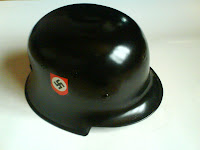


German M1934 Feuerschutzpolizei helmet
Of the civic square dip-type. This is also a restored helmet. After WWII it was used as a regular firehelmet. It was painted red by hand (after 1945), but shapes of decals could still be seen...after cleaning there were 2 decals but in verry bad shape. I cleaned it further up and placed 2 watertransfers on. At least 3 different owners had this helmet when on duty. There are no stamps found on the shell.



German M1934 Feuerschutzpolizei helmet
Lightweight Edelstahl helmet with "Nackenschutz". When the leather skirt is taken off, the brim touches almost the surface, so I think it's the droop billed type. The aluminium comb was taken off and the 3 holes were closed by means of split pens. This was ordered in most regions of the Reich by high ranking police officers (with exception of the Berlin region, but no reason is known by this day). No decals but there is a symbol: circle around PDD (Paul Diener Dresden? This is not confirmed) and an inscription: vorschriftmassig n.V.II. M.d.I.vom 3.5.1934.



German commercially produced Polizei helmet, new model produced about June 1943. It bears a factory applied semi gloss black coat.
Important notice:
* The single air-vent holes on each side (instead of 2 sets in the earlyer helmets given out by the government)!
* The chinstrap, it consists of a buckle type and a sort of snap fastner (like those on WWII Swiss helmets).
* The verry thick gauge steel where the shell is pressed out of, it weighs roughly 1110 grammes, compared with a combat M42 (1380gr.) and a M34 issue Polizeihelmet with no comb (1030gr.).


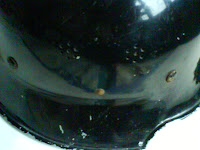

Austrian postwar firehelmet, made after specifications of the famous M34, but under the DIN14940 norm wich had to be followed around 1970. This one is made of an aluminium alloy and has got a much wider brim. No stamps found whatsoever. Aparently the post-WWII Austrian "Länder" were free to choose wich helmet model they wanted. It has got also 6 rivets to hold the liner and chinstrap. The shield in front is of the Steiermark province.




German M1934 Feuerschutzhelmet, of the civic square dip type. Comes with a "Nackenschutz" made out of leather. Holes for the comb are closed with a split rivet. Note the variant in the "salt&pepper" airvents, wich are protruding slightly and are non removable instead of the earlyer ones. Interesting is also the use of smaler split pens. Was in use during and post-war at the "freiwillige Feuerwehr" in Harte...?






German M34 Polizei helmet, made by Robert Lubstein (also known as the Erel company), in Berlin. The helmet is double vented and has a logo of the firm on the dome. The two Polizei decals are scraped away postwar. On the inside of the liner is an ink stamp wich has an eagle and the capital letters L.S. from the Luftschutz? Top of my collection for so far. ;-)



German Luftschutz "Gladiator" helmet, painted semi-gloss black. Stamped RL 2-39/21 wich is the code of F.W. Quist GmbH, Metallwarenfabrik from Esslingen. Strange thing is the fact that the helmet is certainly made out of one piece but has still the beaded shell like those made out of 2 or 3 pieces. (I have only seen one-piece helmets without beaded shells)<-quist strong="">did make shells out of one piece but with a beaded shell! (see: militaria fund forum). description amongst collectors: M38 (3 pieces), M39 (2 pieces), M44 (one piece).







German M1934 Feuerschutzhelmet, of the civic square dip type. Comes with a "Nackenschutz" made out of leather. This variant has got the early removable "salt & pepper" airvents! The Y-shaped chinstrap has got an ink stamp wich says DRP (Deutsches Reichs Patent). Important feature is the addition of a Luftwaffe early "straight legged droop tailed" eagle. This decal is strangely enough placed on the wrong ( right hand) side and the national tri-colored emblem was never applied. About 50% of the decal is scraped away postwar. Another strange fact is also the lack of a white painted ring around the midline. The shell is stamped with a laying lion (Eisenwerk Thale/Harz). Presumably this helmet was used by the Luftwaffe Fire Dept. (Fliegerhorst Feuerwehr) wich was stationed at airfields. Investigation under a magnifying lense gives me confidence of being original...




 German one piece Gladiator helmet, The so called M44 variant. Painted semi-gloss black. As far as I can see, the first and only layer of paint. No Luftschutz decal. No RL-stamp found! Not even a faint trace. Could it be that at the end of WWII those stamps where omitted? Alltough a capital T from Eisenhütte Thale is encountered in the "Nackenschütz" skirt.
German one piece Gladiator helmet, The so called M44 variant. Painted semi-gloss black. As far as I can see, the first and only layer of paint. No Luftschutz decal. No RL-stamp found! Not even a faint trace. Could it be that at the end of WWII those stamps where omitted? Alltough a capital T from Eisenhütte Thale is encountered in the "Nackenschütz" skirt.




German M34 Feuerlöschpolizei helmet. One of the earlyer types, made by EREL (Robert Lubstein). This one is "entnazifiziert", the early decals are scraped away but traces of the Swastica and tilted national emblem can still be seen. They were introduced at 10/07/1934 and retracted at 28/07/1936, when the eagle Polizei emblem was used. The chinstrap is closed with a snap buckle. The liner is fitted with 5 brass screws instead of 4 split pens. Unfortunately the aluminium comb is missing. Verry vaguely stamped with a laying lion, DRP, Thale and a capital A. Early fire dept. members were called Feuerlöschpolizei. Afterwards they were called Feuerschutzpolizei.




German M34 Feuerschutzpolizei helmet, again one of the first series. Made by EREL DRGM (Deutsches Reichs Gebrauchs Muster). No decals found. The chinstrap is closed with a snap buckle. The liner is fitted with 5 splitpens instead of the latter 4. Unfortunately the comb (Ziegelbrecher) and the dome pad (Kopfpolster) are missing. The shell is stamped with a laying lion, DRP, Thale and a capital A.




German M34 Feuerschutzpolizei helmet, of an unknown producer. No stamps or whatsoever found. Comes with a chromed metal comb (wich had to be removed around 1940). Traces of a decal (final form adopted at 28/07/1936) could be seen, but are scraped away postwar. This helmet received a layer of red paint wich was commonly done for the “Freiwillige Feuerwehren” in the Bavarian area from 1945-1964. Afterwards someone repainted it black with a spraycan.




German M34 Feuerschutzpolizei helmet, of an unknown producer. No stamps or whatsoever found. This helmet comes with a rather unusual liner. The padding at the dome is connected with leather to the rest of the outer ring (see pics). This one received a WWII chinstrap wich was normally used by the Wehrmacht! It’s dated 1938 and has got an illegible manufacturers stamp. A capital M denotes adoption by the Marine. The old black paint is covered with an illuminus white paint wich was ordered around 1964. Again a nice exemple of postwar use.





German M34 Feuerschutzpolizei helmet. Early type, made out of Leichtmetal. Holes for the metal comb are closed with lead strips ,wich was done before Scheithauer produced the normal splitpin iron pieces. This was only a temporary measure! Stamped with an unknown factorylogo (<- 2="" 3.5.1934.="" a="" abzeichen.="" aluminiumindustrie="" amp="" and="" any="" away="" be="" bielefeld.="" by="" can="" carl="" clearly="" co.="" didn="" during="" feuerschutzpolizei="" firm="" for="" from="" gesetz="" glued="" helmets.="" henkel="" href="https://blogger.googleusercontent.com/img/b/R29vZ2xl/AVvXsEhv8bs7QhMFoIpQQkfz8oDdoqlXYr7vfHZm9b8_6Ob21PqVY_vzQbK67zkAkG4WirIr-oED5ZwG6DjHmHG4y7j-4k6G8yzML-bOZpAa01dlOo6YcilZdHumF0K9O-sRDJZ2cq28Rv8f7EL8/s1600-h/DSC01702.JPG" is="" it="" j="" large="" last="" liner="" liners="" lische="" lt="" m34="" made="" more="" of="" on="" one="" opfpolster="" original="" other="" produce="" rger="" scraped="" see="" seems="" shell.="" shield="" side="" simply="" ssig="" swastica="" t="" the="" to="" vorschriftm="" war="" was="" westf="" with="" years="" you="">





German M34 Feuerschutzpolizei helmet of an unknown producer. No stamps or whatsoever found. Comes with a rather standard liner and chinstrap. The black leather Nackenschutz has seen quite some action and faded to a rather darkbrown. The helmet received 2 Abzeichen in WWII, but these are scraped away postwar. At the domepadding is a stamp of a Freiwillige Feuerwehr.





German (3 pieces) M38 Gladiator helmet
This is a dark blue painted helmet, issued to the Luftschutzwarndienst. The luftschutzdecal is scraped away postwar. Comes with a typical low-cost liner. The helmet consists of 3 pieces (dome, and front and back brim). Later types were made of 2 or one piece. Inscriptions: RL 2-39/42 (wich means the firm Gustav Rudolph Stanz-, Preß- und Ziehwerk of Bernsbach / Erzgebirge, wich was adorned a contract in 1939 for the production of a Luftschutzhelm (Gladiator Form)). Another paintstamp is: Vertrieb genemigd gemass § 8 Luftschutzgezetz.





German M40 "Ausschusshelm" (Rejected helmet), so called in German. Those helmets received a pressed out ring just above the brim. This was done with helmets wich didn't pass the quality control. There could be small mancos at the shell, e.g, the thickness of the stamped metal etc. All too often those helmets are called "Kradmelderhelmets" wich is totally wrong!!! This helmet is made by EF wich stands for Emaillierwerke A.G., Fulda and was adopted by the Luftschutz. There are some features wich tells us that it is in fact a latewar helmet because there is a factory applied ersatz liner, made out of fabric and the use of a "Supron band" chinstrap. This particular liner was made by G. R. Haufe/Sa. Bezirk Dresden. The use of more ersatzmaterial was adopted on 21/06/1943.





German M38 (3 pieces) Gladiator helmet.Typical dark blue painted steel helmet, issued to the Luftschutzwarndienst. The Luftschutzdecal is about 75% intact. Not “entnazifiziert”. The liner has got some resemblance ot those issued on M16 steel helmets of WWI. This one is made by Paul Diener from Dresden (RL2-38/28).





German M38 (one piece) Gladiator helmet. Already painted black instead of dark blue. The swastica on the decal is scraped away postwar. I'm not sure if the liner is genuine to it or postwar... Made by Carl Busse of Mainz (RL 2-39/30).





German M34 Firehelmet model, painted blue for use with the Luftschutz. That's why a "Luftschutzschwinge" is placed in front of the helmet. Unfortunately the swastica is scraped away from the decal. It has got protruding salt&pepper airvents. A paintstamp at the backskirt says: FD144...propably some unit's name or could it be FeuerlöschDienst or FlugmeldeDienst? No stamps found on the shell. The liner is in fact a French one (for the Adrian helmet), wich was used as a stopgap measure when German liners were in short supply.









German M18 clone, produced in the early twenties for civil organisations like the Feuerwehr or Polizei. This helmet comes with 2 holes on each side. This was used to pin on the firedepartments symbols (a swastica and national shield). Those symbols were used from 10/07/1934 till 28/07/1936, when the swastica was replaced with the Polizei eagle. As a matter of fact there were transfer decals placed on the helmet, but sadly enough scraped away. At the front side of the helmet was also some decal, but definitely not a RLB star (not even the verry early small one). It could be a “Stadtwappen” civic crest. It’s clear that the helmet received another layer of black paint long time ago. The aceton test with a Q-tipp points out that the paint is very difficult to remove. No markings found in the shell.







German M34 Firehelmet. Unusual liner in one piece. (Seems to be of the same type like the other one of my collection, wich is painted white). The shell is stamped with DRP Thale and a capital A. The chinstrap is of important notice! This is clearly NOT a postwar production. It could be made for the company of Konrand Rosenbauer of Wien (Austria). It is stamped with a patents number wich is 1590400 (dep. on june 29, 1926). The helmet received another layer of black paint postwar wich can be easely removed with aceton.







German M34 firehelmet with it's comb removed. The holes are closed with lead or tin. The Liner is made by Carl Henkel of Bielefeld. It resembles closely the "Innenausstattung M31" liner. Unfortunately 2 of the 5 leather tabs are torn off. No stampings are found except the "Thale-stahl" proofmark. The Polizei decal was adopted on 28/07/1936 in it's final form.






East-German Polyester helmet (2nd model). This one is produced in 1957. It was produced by the VEB Hüte und Mützen Berlin C2 (in wich VEB stands for VolksEigeneBetrieb).
I bought this helmet to show you the subtile differences between REAL "paradehelmets" and DDR firemans helmets wich are often on sale as original Fiberhelmets!!!
short overwiew:
*Paradehelmets were produced between the 20'ies till 1945 (NOT LATER!!!!). They were made out of a sort of syntetic fiber, called "Vulkanfiber". That's why they were often stamped with D.R.G.M. FIBERHELM. On the inside you can find also an RB-number from time to time. Those helmets had a single chinstrap.
*First model firehelmets were produced in the early 50'ies till 1955, by the firm of Robert Lubstein and the "could" sometimes have liners with RB-numbers because R. Lubstein used leftover stocks of wartime materiél. Those Vulkanfiberhelmets had slightly different screened vents and iron band to strenghten the helmet. They were also adorned with a single chinstrap.
*Second model firehelmets were produced from 1955 till ~1962. They were made out of some sort of polyester. Those helmets had a chinstrap in the form of a Y. The form of the dome was also a little bit more flat at the end of the production runs. Also the color changed from black to a metallic grey hammerpaint.
*There is also a third model if I recall wich had a liner made out of leather and a cloth X, in wich it was suspended. Those helmets were all painted grey with hammerpaint.





German three pieces M38 Luftschutzhelmet. Made by Carl Busse from Mainz (RL 2-39/11). This helmet is postwar overpainted, but I restored it as much as I could. There was a Luftschutzdecal under the thick layer of white paint. This is censored in the picture. Unfortunately there was no liner, only the splitpens.





German M38 three piece Luftschutz helmet. Made by Maury & Co., Offenbach (RL2-38/31).
This manufacturor is rather scarce on the collectors market. The liner is made in a standard configuration. Unfortunately the Luftschutz decal is “entnazifiziert.




German M38 one piece Luftschutz helmet, painted semi-gloss dark blue on the outside and the inside of the brim. Stamped RL 2-39/21 wich is the code of F.W. Quist GmbH, Metallwarenfabrik from Esslingen. The dome is painted Luftschutz-blue on the inside. There are signs that the helmet received minimal 3 layers of paint! (L.S. blue, red and semi-gloss dark blue). Each layer being carefully removed before the other one was applied. The liner is also once replaced! It could have been done during WWII, because they used a genuine, early type firedept. liner, with the omission of a dome padding! Altough it seems to have a post-war chinstrap!









German verry early M34 model firehelmet. The airholes are covered with wired mesh. The comb has been removed and the holes closed with splitpens. The helmet received Polizei decals of the second type (with small white border on the eagle decal). Unfortunately those items are “entnazifiziert” at the end of the war. The liner is fastened with 3 pens and 2 separate pens for the chinstrap. The liner itself has got a leather headband instead of the usual inpregnated cardboard. They also adopted 3 leather pads with cussions like the older liners. The dome padding is fastened with just 2 leather strips. No stamps were found on the shell.







German M18 model, commercially produced in the early 1920-ies. This helmet has got a leather headband and 3-cussions system. It seems like it’s fitted with an Austrian type of liner (iron rivets in the crown). On the front there are 2 rivets wich closed the holes in front of the helmet. Those holes were there to fit a municipal shield. On the side you will notice also holes to fit some city- or province shields. Later on those holes were used to fit the early Polizei decals. No stamps found on the shell.





German M44 Luftschutzhelmet, made by an unknown producer. No RL-stampings found in the shell, except a vague stamping in te form of a letter A?! The helmet has got a latewar fabric liner and a Supron chinstrap. Latewar helmets didn't receive the LS-decal anymore. Probably this helmet was never worn.

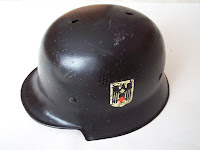




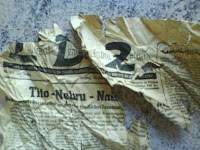
German early M34 model firehelmet. This type has got holes for a comb, wich latter is already removed. The holes aren’t closed with splitpens! It seems that the shell received another layer of black paint (genuine or postwar? This will be dealt later). The helmet is adorned with a DRK (Deutsches Rotes Kreuz) decal. This one has got a more rounded bottom instead of the much frequenter pointed shield. At first sight the decal is also a little larger than the “original” ones. Some collectors state that the rounded version is a high-end reproduction wich could be dated in the ’50-ies. Photographic evidence of rounded shields is not known to me. Conclusion: I’ve found some newspaper tucked between the liner ring (wich is stamped with DRGM 1341086= Deutsches Reichs Gebrauchs Muster ) and the shell. This paper was of German origin: Liberal Demokratische Zeitung, of July 1956. Why would a previous (postwar) owner adapt his liner, but not denazify his helmet??? To me it is also a forgery, altough the previous owner said it was 100% genuine!





German M38 Luftschutz helmet, made in 3 pieces and painted semi-gloss dark blue. Made by RL 2-38/29 (wich is the firm of Eisenhüttenwerk Thale in the Harz region. This firm produced and assembled the metal parts. The liner etc. was produced and fitted by the firm of Fr. Schlemmer (wich made Pickelhaubes and Firehelmets before), as can be seen by the company’s logo. Unfortunately the "Luftschutzschwinge" is scraped away postwar.




German three piece M38 Luftschutzhelmet. The front decal is carefully removed (presumably postwar). The strange fact is that the helmet received 2 RL-stampings!!! These are RL 2-38/29 and RL 2-39/11. I've never seen such a misstamping before...





German one piece M38 Luftschutzhelmet. Stamped with RL2-39/25 wich is the Eisenhüttenwerk Thale, Thale (Harz). The decal is 100% intact. Unfortunately someone cut off the chinstrap.



German two pieces M39 Luftschutzhelmet. Unfortunately in verry bad shape. No paint or liner. The shell is so corroded that the RL-number is not readable.








German M40 Ausschusshelm, given out at the Luftschutz. The decal is 100% intact. The liner is made out of ersatzmaterial. In this case some canvas cloth. You can clearly see why this helmet is rejected for frontline use. the side at the front visor has some damage wich is carefully welded. Stampings in the shell are: Q64, made by Quist and the lotnumber DN211.





German M40 Ausschusshelm in nearly mint condition, made by Quist (shellsize 62). There was never a Luftschutzdecal applied. The shell is stamped with a productionnumber ??148. The liner is made out of a latewar synthetic material.





German M34 fire helmet, Probably made by the Gebrüder Büsch in Remscheid. The Hirsch logo of the firm can be seen at the side of the skirt. The company was founded on may 30. 1885 and made metal goods till the sixties of next century. This helmet is made without holes for the comb. This was regulated at 23/11/1938 and adopted not sooner as 02/07/1940. Unfortunately there are only traces of one decal present.





German M34 Medium Duty helmet, original designated to be worn by members of the TeNO (Technische Nothilfe) but also frequently seen in use by members of the SD (Sicherheids Dienst). The helmet looks like a normal M34 at first sight, but there are one-holed cooling vents stamped out instead of the normal 7-holed vents. Normally this helmet had a liner without “Kopfpolster” dome padding, but this is likely replaced postwar...? Although this is a gennuine WW2 liner. There is only a vague stamping wich says “Edelstahl”.






German M34 fire helmet, made out of aluminium. This helmet has the famous BXF logo, wich is the Westfälische Aluminiumindustrie Jürger & Co.. The decals are only vaguely present due to an overpainting postwar (wich is now removed the best I could). Traces of the comb can be seen on top of the shell, where the holes are closed with splitpens due to regulations. This helmet belonged to the Freiwillige Feuerwehr Horstmar.







German M34 fire helmet, made out of aluminium. This is a verry early model with vent holes wich are removable and protruding slightly. The shellform was adopted on 03/05/1934 and there are traces of a tilted national shield and verry vaguely a swastica on the other side. Those decals were adopted at 10/07/1934. Notice the extra rivet for the chinstrap! The First one is the origninal rivet, the second a field made repair. This helmet also belonged to the FFW Horstmar.





German M38 Luftschutzhelmet, made out of 3 pieces. Painted green for use by the Protivovazdushna i Himimicheska Zashtita (the Bulgarian Anti-Air and Chemical Defence). Stamped with RL 2-38/28 . This was the antithesis of the German Luftschutz. Those helmets were delivered between 1941(?) and september 1944. The first batch was still in original Luftschutzblau paint, with the LS decal carefully removed and the Bulgarian shield added to the side. Later on they were painted green. In february 15. 1944 there was a last batch of 15000 helmets ordered at the Eisenhüttenwerk Thale, to be delivered before september. Known producers of shells were: Paul Diener, Eisenhüttenwerk Thale and possibly Raffelenbeul & Sohn.... All three kind of models were delivered to Bulgaria.




German M38 Luftschutzhelmet. Another shell, made out of 3 pieces. Delivered to the Bulgarian Anti-Air and Chemical Defence. Stamped with RL2-38/29.







German M34 Firehelmet, made after 1940 (shell with no holes for the comb) OR after 1943 when the new type of M34 was introduced. Fact is that the “Kopfpolsterung” domepadding is still loose in the shell (like the early ones). The shell is originally painted green ,for use by ??? The liner is made by Albert Diedrich Domeyer, Dresden, Osterfeuerbergstrasse. This points out that the helmet is genuine of WWII origin, because A.D. Domeyer had his company in Horn postwar. (More info in the last picture).






German M42 combat helmet, made by HKP (Sächsische Emaillier und Stanzwerke AG, Lauter). The shell is of size 66 and has got a 58 size liner. Unfortunately the zinc liner is a bit detoriated so the stamping is not legible anymore. The R.B.Nr. on the leather liner is partially readable. Due to lack of oxygen the leather is practically preserved as new. This helmet was found in Austrian lake (20m depth, 50cm in the mud), were retreating Germans left their fieldgear.




German M38 3-pieces Luftschutzhelmet. The decal is unfortunately carefully removed postwar. Verry few traces of use. This helmet is made by Rafflenbeul & Sohn, Press- und Stanzwerk, Hückeswagen (Rheinland.) RL2-39/10. It was found in the fall of 2009 in the buildings of the Schwelmer Eisenwerk Müller & Co. GmbH in Schwelm, Gemany. Probably used by the Werkluftschutz and postwar by the Werkfeuerwehr. Up to the 60-ies of the 20. century the Schwelmer Eisenwerk was the biggest manufacturer of fuel dispensers/gasoline pumps worldwide. Tank trucks were also build in Schwelm and used around the world.





German M38, 3-pieces Luftschutzhelmet. This decal is also removed postwar...(Just before I was going to buy it, the seller received a message from Eb*y because there was a swastica vissible!!! So he removed it...*sigh*). Overall minimum wear, but it has some dents like there was someone at work with an axe or something. Unfortunately there is no liner anymore, but it had probably a three piece liner like the ones in German WWI helmets. This one is stamped with RL 2-40/2 wich is from the Gebrüder Gräbner, Crottendorf im Erzgebirge.
6 opmerkingen:
hi,
i have one of the air carabine sport model 49A seen in your blog can you tell me where i can find parts (if possible now) thank you for your help
cb
Hi cb,
Nice to come by to my blog/website!
You can try:
www.co2air.de (German site)
www.luchtbuks.net (Dutch site)
Those guys must have got something at least. Allthough you have to register to use the forum.
From wich country are you anyway?
Kind regards,
Christophe
hello my name is LUCA , from Italy, i am militaria collector, sunday i go for 3 days in Belgium , bruxelles, did you can help me to finf good shops and marketplaces? if you give me your email i email you,regards and my compliments for your collection.
Hello Sir,
I saw your nice collection of German WW2 Fireman and for what somebody told me, the war period type must have the smaller holes on the side in a vertical position, mean one hole on top and one on the bottom to have a vertical esagon. It's true?
Thanks
Vinz
Hey Vinz,
sorry for the late reply!
Helmets had holes for the comb (3 pieces, 2 on top and one in the skirt) till 23/11/1938. Afterwards the aluminium was used for the war effort and the holes had to be closed by means of split pens or lead/brass brazing. It was not sooner as 02/07/1940 that the production of helmets "without" holes was made...
If you have any questions just mail me at christophegeboors "at" hotmail.com
Greetings,
Christophe
Tips to Take Effective Screenshots: A blog with helpful screenshot tips...ashampoo snap 11 license key
Een reactie posten